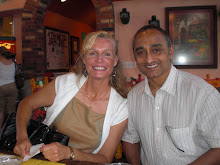
I just heard the sad news today that Indira Goswami had passed away. I have my google alerts set on Vrindavan Widow so that I can keep abreast of any news that affects our work. Today the alert was about a remarkable woman who was a source of inspiration when my husband Dharan wrote the screenplay for our film "White Rainbow". Many times people ask me who the protagonist in "White Rainbow" is based on and I always mention that the character is loosely based two women, one is a young affluent widow that was suicidal, but eventually went to Vrindavan and started helping the widows there.
Read the articles below and you will see the similarity. I am thankful that Indira spoke out and wrote about such a sensitive and personal issue so that many others can be helped!
Excerpts from The Hindu Newspaper
Indira Goswami, who died on Tuesday aged 69, was among India's most celebrated contemporary writers whose work spoke boldly and evocatively for the empowerment of women and other marginalised sections of society across the country. For this, she won the nation's highest literary honours, and respect and adulation in her home State Assam, where she was known as “baideiu” or elder sister. Far ahead of its times, her Neelkantha Braja was one of the earliest works of Indian literature to highlight the exploitation of destitute widows in Vrindavan. The book was born out of Goswami's own early widowhood, and a short experimental stay in a widows' home in the U.P town. Her frank Adhalekha Dastavej (An Unfinished Autobiography), written in 1988, details her battle with intense depression after her husband's death, her nights with sleeping tablets, handfuls of which she swallowed in two attempts to end her life, and the story of how she won the struggle by immersing herself completely in her writing. From Wikipedia After the sudden death of her husband, in a car accident in the Kashmir region of India, after only eighteen months of marriage, she became addicted to heavy doses of sleeping tablets
Her experiences as a widow as well as a researcher finds expression in her novel The Blue Necked Braja (1976), which is about the plight of the widows of Vrindavan who lived in abject poverty and sexual exploitation in everyday life. One of the main issues that the novel touches upon is the plight of young widows for whom companionship beyond the confines of their ashrams and fellow widows become impossible. Their urge to live, as well as the moral dilemma that they face vis-a-vis the order of precepts of religion in this regard, are brought out with astonishing clarity and feeling in the novel. The novel exposed the uglier face of Vrindavan — the city of Krishna, an Hindu deity — inviting criticism of Goswami from conservative sections of the society. It remains a classic in modern Indian Literature. It is autobiographical in character as she says the anguish of the main character Saudamini, reflects what she had gone through after her husband had died. It was also the first novel to be written on this subject. The novel was based on Goswami's research on the place as well as real-life experience of living in the place for several years before she joined the University of Delhi as a lecturer.



No comments:
Post a Comment